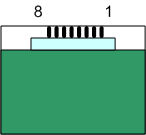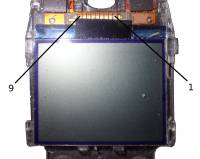Published 8 Dec 2020
Nokia Monochrome Displays
Overview
A series of Nokia cellphones in the 1990s used small black and white FSTN LCDs. These had a simple SPI like serial interface and could be easily driven with 5 control lines from an Arduino. Their small size (about 42mm square) and low power consumption make them ideal for portable Arduino projects. They have very good contrast in daylight, and can be mounted with external back-lighting. Much of the following information is from www.module.ro, by Bergthaller Iulian-Alexandru, and a copy of lcdtable.xls (“Mobile Phone LCD Controllers & specs”), dated 18 August 2011 2:35:39 PM, by Vladimir Bakum ( (R)soft).
Many of the displays can be extracted from old cellphones but have either elastomeric rubber or contact pins as their connector which makes them a little difficult to wire-up to other devices, so they are usually sold mounted on a small circuit board which brings the signals out to 0.1” spaced header pins.
| Nokia monochrome cellphone LCDs | |||||||
|---|---|---|---|---|---|---|---|
| Phone | Resolution1) | Chip | LCD | Part num2) | Pinout | Interface | Voltage |
| 1610 | 2 rows x 8 chars plus icons | ||||||
| 1611 | 2 rows x 8 chars plus icons | ||||||
| 1620 | 2 rows x 8 chars plus icons | ||||||
| 1630 | 2 rows x 8 chars plus icons | ||||||
| 1631 | 2 rows x 8 chars plus icons | ||||||
| 2010 | 2 rows x 8 chars plus icons | ||||||
| 2160 | 3 rows x 10 chars plus icons, plus 12 chars3) | ||||||
| 2168 | 3 rows x 10 chars plus icons, plus 12 chars | ||||||
| 2170 | 3 rows x 10 chars plus icons, plus 12 chars | ||||||
| 2180 | 3 rows x 10 chars plus icons, plus 12 chars | ||||||
| 2190 | 3 rows x 10 chars plus icons, plus 12 chars | ||||||
| 2110 | 4 rows x 13 chars plus icons | ||||||
| 2110i | 4 rows x 13 chars plus icons | ||||||
| 2120 | 4 rows x 13 chars plus icons | ||||||
| 3110 | 83×41 plus 1 row icons4) | ||||||
| 3810 | 4 rows x 13 chars plus icons5) | ||||||
| 1220 | 84×48 | PCD85446) | |||||
| 1221 | 84×48 | PCD8544 | |||||
| 1260 | 84×48 | PCD8544, OM62177) | LPH7815-18) | ||||
| 1261 | 84×48 | PCD8544, OM62179) | LPH7815-110) | ||||
| 2220 | 84×48 | PCD8544 | 4850352 | ||||
| 2260 | 84×48 | PCD8544 | |||||
| 3210 | 84×48 | PCD8544/ OM20611) | LPH767712) | pinout-2 | |||
| 3210 | 84×48 | PCD8544 | LPH7677-1 | 4850107 | pinout-2 | serial SPI | 2.7V - 3.3V |
| 3280 | 84×48 | PCD8544 | |||||
| 3285 | 84×48 | PCD8544 | |||||
| 3310 | 84×48 | PCD8544/ OM620613) | LPH777914) | 485012315) | pinout-2 | serial SPI | 2.7V - 3.3V |
| 3315 | 84×4816) | PCD8544 | LPH777917) | ||||
| 3320 | 84×48 | PCD8544, OM621718) | LPH7815-119) | ||||
| 3330 | 84×48 | PCD8544 | LPH777920) | 485012321) | pinout-2 | ||
| 3360 | 84×48 | PCD8544, OM621722) | LPH7815-123) | ||||
| 336124) | 84×48 | PCD8544, OM6217 | LPH7815-1 | ||||
| 3390 | 84×48 | PCD8544 | |||||
| 3395 | 84×48 | PCD8544 | |||||
| 5110 | 84×48 FSTN | PCD8544 | LPH736625) | 4850113 | pinout-1 | serial SPI | 2.7V - 3.3V26) |
| 5120 | 84×48 | PCD8544 | LPH736627) | pinout-1 | |||
| 5120 | 84×48 | PCD8544 | 4850057 | pinout-1 | |||
| 5125 | 84×48 | PCD8544 | 4850235 | ||||
| 5130 | 84×48 | PCD8544 | LPH736628) | 4850113 | pinout-1 | serial SPI | 2.7V - 3.3V29) |
| 5160 | 84×48 | PCD8544 | LPH736630) | pinout-1 | |||
| 5160 | 84×48 | OM6206 / PCF8812 / PCD854431) | LPH7779 | serial SPI | 2.7V - 3.3V | ||
| 5165 | 84×48 | PCD8544 | |||||
| 5170 | 84×48 | PCD8544 | |||||
| 5170i | 84×48 | PCD8544 | |||||
| 5180iP | 84×48 | PCD8544 | |||||
| 5185i | 84×48 | PCD8544 | |||||
| 5190 | 84×48 | PCD8544 | |||||
| 5210 | 84×48 | PCD8544 | 4850205 | ||||
| 5210 | 96×6532) | serial | |||||
| 5510 | 84×48 | PCD8544 | 4850219 | ||||
| 6090 | 84×48 | PCD8544 | |||||
| 6110 | 84×48 | PCD8544 | LPH736633) | 4850113 (SEIKO) | pinout-1 | serial SPI | 2.7V - 3.3V34) |
| 6120 | 84×48 | PCD8544 | 4851025 | ||||
| 6130 | 84×48 | PCD8544 | 4850113 (SEIKO) | ||||
| 6138 | 84×48 | PCD8544 | |||||
| 6150 | 84×48 | PCD8544 | LPH736635) | 4850113 (SEIKO) | pinout-1 | serial SPI | 2.7V - 3.3V36) |
| 6160 | 84×48 | PCD8544 | |||||
| 6162 | 84×48 | PCD8544 | |||||
| 6190 | 84×48 | PCD8544 | |||||
| 8210 | 84×48 | ||||||
| 8250 | 84×48 | ||||||
| 8260 | 84×48 | ||||||
| 8265 | 84×48 | ||||||
| 8265i | 84×48 | ||||||
| 8270 | 84×48 | ||||||
| 8290 | 84×48 | ||||||
| 8310 | 84×48 | OM621137) | 949030638) | pinout- | serial39) | 2.8V | |
| 8390 | 84×48 | ||||||
| 881040) | 84×48 | PCD8544 | LPH7366 | serial SPI | 2.7V - 3.3V | ||
| 8850 | 84×48 | ||||||
| 8855 | 84×48 | ||||||
| 8860 | 84×48 | ||||||
| 8890 | 84×48 | ||||||
| 8910 | 84×48 | ||||||
| 8910 | 96×6541) | 01150P00204DP | serial | ||||
| 1100 | 96×65 | PCF881442) | 4850341 | pinout-2a | serial SPI | 2.8V & 1.8V | |
| 1101 | 96×65 | PCF881443) | 4850853 | ||||
| 1108 | 96×65 | ||||||
| 2100 | 96×65 | Samsung (green) , Seiko-Epson (red), Philips (blue) | 4850279 | pinout-2 | serial | ||
| 2112 | 96×65 | ||||||
| 2115 | 96×65 | ||||||
| 2115i | 96×65 | ||||||
| 2116i | 96×65 | ||||||
| 2118 | 96×65 | ||||||
| 2270 | 96×65 | OM621144) | |||||
| 2272 | 96×65 | ||||||
| 2280 | 96×65 | ||||||
| 2285 | 96×65 | ||||||
| 2300 | 96×65 | PCF881445) | 4850365 | serial SPI | |||
| 2855i | 96×6546) | ||||||
| 3315 | 96×65 | OM6206 / PCF8812 / PCD854447) | LPH7779 | serial SPI | 2.7V - 3.3V | ||
| 3350 | 96×65 | OM6206 / PCF8812 / PCD854448) | LPH777949) | pinout-2 | serial SPIO | 2.7V - 3.3V | |
| 3410 | 96×6550) | OM620651) | LPH777952)/ PCF8812 / PCD854453) | 485033554) | pinout-2 | serial SPI | 2.7V - 3.3V |
| 3410 | 84×4855) | OM6206 / PCF8812 / PCD854456) | LPH7779 | serial SPI | 2.7V - 3.3V | ||
| 3510 | 96×65 | Seiko-Epson (2.7 mm thick) or Philips (1.7 mm thick) | 485024757) | pinout-4 | |||
| 351058) | 98×67 | OM6211 PCF8814 | serial | 2.7V & 1.8V | |||
| 3570 | 96×65 | ||||||
| 3585 | 96×65 | ||||||
| 3585i | 96×65 | ||||||
| 3590 | 96×65 | ||||||
| 3610 | 96×65 | 4851038 | |||||
| 6210 | 96×65 | LPH7690-159) | 4850171 | ||||
| 6210 | 96×65 | LPH769060) | 4850171 | serial | |||
| 621061) | 96×60 | PCD8544 | LPH7690 | serial SPI | |||
| 6250 | 96×65 | ||||||
| 6310 | 96×65 | pcf8511 / pcf8813 ? | 485016362) | pinout-4 | |||
| 6310i | 96×65 | 4850163 | |||||
| 6340 | 96×65 | ||||||
| 6340i | 96×65 | ||||||
| 6360 | 96×65 | ||||||
| 6370 | 96×65 | ||||||
| 6385 | 96×65 | ||||||
| 6500 | 96×65 | 4850973 | |||||
| 6510 | 96×65 | ||||||
| 6510 | 84×4863) | OM6211 | serial | 2.8V | |||
| 6590 | 96×65 | ||||||
| 6590i | 96×65 | ||||||
| 7110 | 96×6564) | SED156565) | 9480401, P31303290166) | pinout-3 | serial | 3V67) | |
| 7160 | 96×65 | ||||||
| 7190 | 96×65 | ||||||
| 8280 | 96×65 | ||||||
| 831068) | 98×67 | OM6211 PCF8814 | serial | 2.7V & 1.8V | |||
| 1110 | 96×68 | WD-G0906XH69) | serial | 2.8V | |||
| 1110i | 96×68 | STE9668D70) | WD-G0906YH | serial | 2.8V | ||
| 1112 | 96×68 | STE9668D71) | WD-G0906WY | serial | 2.8V | ||
| 111672) | 96×68 | serial | 2.8V | ||||
| 120073) | 96×68 | serial | 2.8V | ||||
| 1202 | 96×68 | STE2007 NT7542(NT75421??)74) | serial | ||||
| 1203 | 96×68 | STE2007 NT7542(NT75421??)75) | serial | ||||
| 1280 | 96×68 | STE2007 NT7542(NT75421??)76) | serial | ||||
| 6085 | 96×6877) | ||||||
(bold = examples seen, italic = alternative docs)
Hardware description
The 84×48 displays are controlled by a surface mounted (chip on glass) Philips PCD8544, and the 96×65 displays often have a Philips OM6206 controller.
The common Nokia 3310/5110 display has a graphics display area of 84×48 pixels, and are about 38mm (1.5”) square. They require a 2.7V to 3.3V power supply and draw low current (< 8mA) if there is no backlight on.
The unmounted LCDs (ie not mounted on a small circuit board) have the following pin-outs 78):
pinout-1 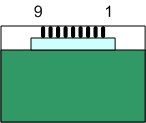 79)
79)
| The LPH7366 has 9 pins: | ||
|---|---|---|
| Pin | Label | Description |
| 1 | VDD | 2.7V - 3.3V |
| 2 | SCLK | Clock |
| 3 | SDIN | Data in |
| 4 | D/C | Data or command |
| 5 | SCE | Chip select |
| 6 | OSC | Oscillator input (Vdd for internal or 32768Hz external clock) |
| 7 | VSS | Ground |
| 8 | VLCD | DC/DC voltage converter |
| 9 | RES | Reset |
pinout-2 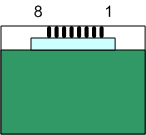
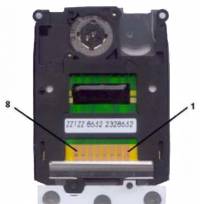
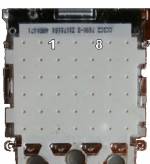 80)
80)
| The LPH7779, LPH7690 81) and LPH7677 have 8 pins | ||
|---|---|---|
| Pin | Label | Description |
| 1 | VDD | 2.7V - 3.3V |
| 2 | CLK | Clock |
| 3 | SDIN | Data in |
| 4 | D/C | Data or command |
| 5 | SCE | Chip select |
| 6 | VSS | Ground |
| 7 | VLCD | DC/DC voltage converter |
| 8 | RES | Reset |
When mounted as small LCD modules on a circuit board, there a few variations of pinout, eg:
| Connector pin-out | |||
|---|---|---|---|
| Diymore | Sparkfun | Adafruit | |
| Pin# | Label | Label | Label |
| 1 | Rst | Vcc | Gnd |
| 2 | CS | Gnd | Vcc |
| 3 | D/C | CS | Clk |
| 4 | DIn | Rst | DIn |
| 5 | Clk | D/C | D/C |
| 6 | Vcc | DIn | CS |
| 7 | LED | Clk | Rst |
| 8 | Gnd | LED | LED |
| Key | |
|---|---|
| Rst | Reset |
| CS | Chip Selection |
| D/C | Data/Command |
| DIn | Serial Data Line |
| Clk | Serial Clock |
| Vcc | 2.7V to 3.3V |
| LED | Backlight Control |
| Gnd | Power Ground |
| Nokia 1100 LCD has 9 pins, but only 8 brought out | ||
|---|---|---|
| Pin | Label | Description |
| 1 | XRES | Reset |
| 2 | XCS | Chip select |
| 3 | Vss | Ground |
| 4 | SDA | Data in |
| 5 | SCLK | Clock |
| 6 | VddI | 1.8V (VIO) |
| 7 | Vdd | 2.8V |
| 8 | LED+ | Backlight |
| 9 | - | - |
pinout-3 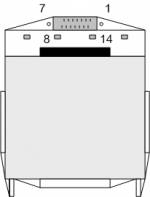 82)
82)
| Nokia 7110 LCD has 14 pins | ||
|---|---|---|
| Pin | Label | Description |
| 1 | Temp sensor | 47k (at 25C) |
| 2 | _CS | |
| 3 | Speaker_p | |
| 4 | D/_C | |
| 5 | SCLK | (max. 3.2MHz at Vlogic=+2.8V) |
| 6 | Speaker_n | |
| 7 | On/Off | |
| 8 | Led - | |
| 9 | Led + | |
| 10 | Gnd | |
| 11 | Gnd | |
| 12 | Vlogic | (+ 2.8V) |
| 13 | SDATA | |
| 14 | _RESET | |
pinout-4 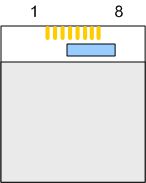
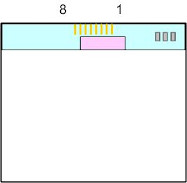 83)
83)
| Nokia 3510 LCD has 8 pins | ||
|---|---|---|
| Pin | Label | Description |
| 1 | Reset | Reset |
| 2 | CS | Chip select |
| 3 | GND | Ground |
| 4 | SData | Serial data in |
| 5 | Sclk | Serial clock |
| 6 | Vio | 1.8V |
| 7 | Vbooster in | 2.7V |
| 8 | Vlcd | from internal dc/dc converter, max.12V |
| Nokia 8310 LCD has 8 pins | ||
|---|---|---|
| Pin | Label | Description |
| 1 | Reset | Reset |
| 2 | CS | Chip select |
| 3 | Vss | Ground |
| 4 | SDA | Serial data in |
| 5 | SClk | Serial clock |
| 6 | Vdd1 | 1.7V - 2.3V, typ 1.8V |
| 7 | Vdd2/3 | 2.5V - 4.5V, typ 2.78V |
| 8 | Vout | to 1uF capacitor |
References and Additional Resources
- lcdtable.xls(en) Mobile Phone LCD Controllers & specs by Vladimir Bakum
Datasheets
- ET_LCD5110 84 x 48 LCD module.
- GG0804A1FSN6G 5110 84 x 48 LCD module.
- Philips PCD8544 LCD controller used in many 84 x 48 modules.
Hookup and test code examples
- http://hobby.abxyz.bplaced.net/index.php?aid=10&pid=3 AVR-GCC course LCD display from Nokia 3310 (Polish).
Libraries
- Serdisplib, a library to drive serial displays with built-in controllers.
If any referenced page no longer exists, try looking for its URL on http://archive.org.

